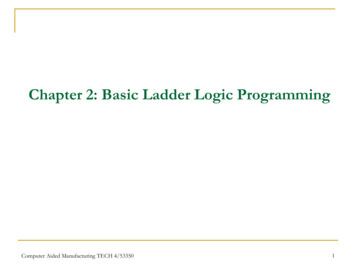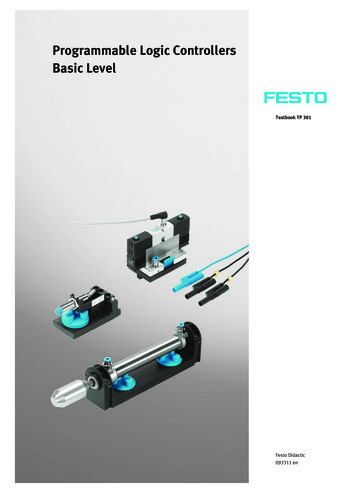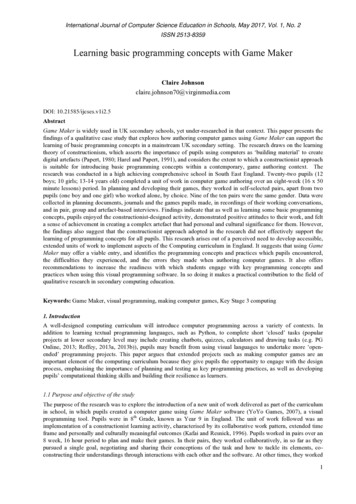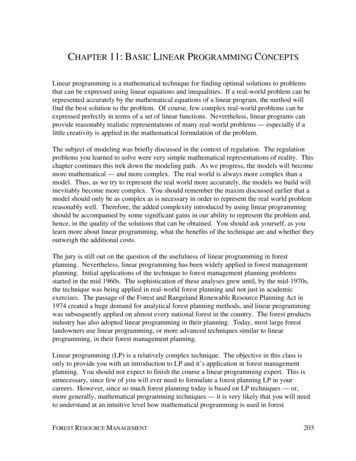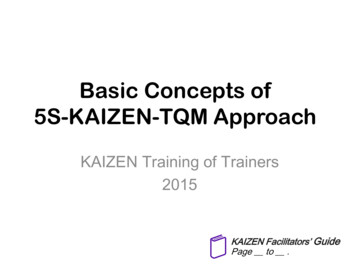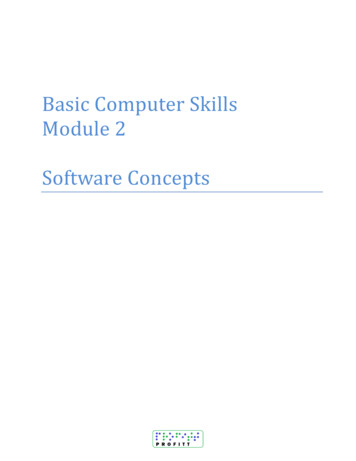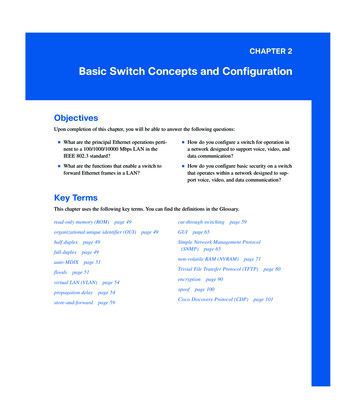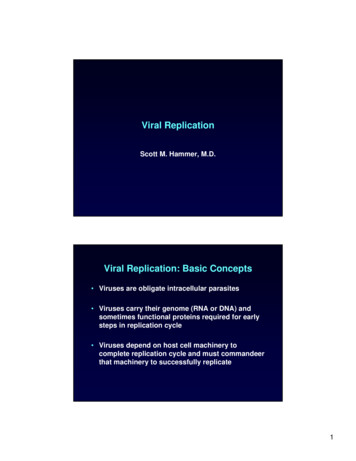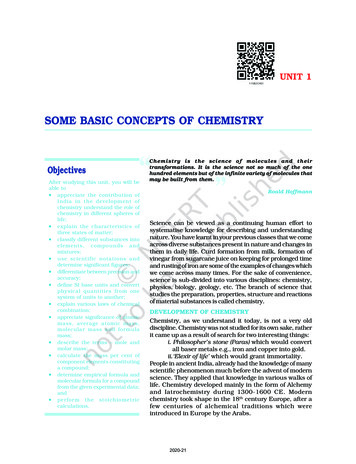
Transcription
BASIC CONCEPTSOF LOGIC1.2.3.4.5.6.7.8.9.10.11.What is Logic? .2Inferences and Arguments .2Deductive Logic versus Inductive Logic .5Statements versus Propositions .6Form versus Content .7Preliminary Definitions.9Form and Content in Syllogistic Logic .11Demonstrating Invalidity Using the Method of Counterexamples .13Examples of Valid Arguments in Syllogistic Logic .19Exercises for Chapter 1 .22Answers to Exercises for Chapter 1 .25
21.Hardegree, Symbolic LogicWHAT IS LOGIC?Logic may be defined as the science of reasoning. However, this is not tosuggest that logic is an empirical (i.e., experimental or observational) science likephysics, biology, or psychology. Rather, logic is a non-empirical science likemathematics. Also, in saying that logic is the science of reasoning, we do not meanthat it is concerned with the actual mental (or physical) process employed by athinking entity when it is reasoning. The investigation of the actual reasoning process falls more appropriately within the province of psychology, neurophysiology, orcybernetics.Even if these empirical disciplines were considerably more advanced thanthey presently are, the most they could disclose is the exact process that goes on ina being's head when he or she (or it) is reasoning. They could not, however, tell uswhether the being is reasoning correctly or incorrectly.Distinguishing correct reasoning from incorrect reasoning is the task of logic.2.INFERENCES AND ARGUMENTSReasoning is a special mental activity called inferring, what can also be calledmaking (or performing) inferences. The following is a useful and simple definitionof the word ‘infer’.To infer is to draw conclusions from premises.In place of word ‘premises’, you can also put: ‘data’, ‘information’, ‘facts’.Examples of Inferences:(1)You see smoke and infer that there is a fire.(2)You count 19 persons in a group that originally had 20, and you inferthat someone is missing.Note carefully the difference between ‘infer’ and ‘imply’, which aresometimes confused. We infer the fire on the basis of the smoke, but we do notimply the fire. On the other hand, the smoke implies the fire, but it does not inferthe fire. The word ‘infer’ is not equivalent to the word ‘imply’, nor is it equivalentto ‘insinuate’.The reasoning process may be thought of as beginning with input (premises,data, etc.) and producing output (conclusions). In each specific case of drawing(inferring) a conclusion C from premises P1, P2, P3, ., the details of the actualmental process (how the "gears" work) is not the proper concern of logic, but ofpsychology or neurophysiology. The proper concern of logic is whether the inference of C on the basis of P1, P2, P3, . is warranted (correct).Inferences are made on the basis of various sorts of things – data, facts, information, states of affairs. In order to simplify the investigation of reasoning, logic
3Chapter 1: Basic Conceptstreats all of these things in terms of a single sort of thing – statements. Logic correspondingly treats inferences in terms of collections of statements, which are calledarguments. The word ‘argument’ has a number of meanings in ordinary English.The definition of ‘argument’ that is relevant to logic is given as follows.An argument is a collection of statements, one ofwhich is designated as the conclusion, and theremainder of which are designated as the premises.Note that this is not a definition of a good argument. Also note that, in the contextof ordinary discourse, an argument has an additional trait, described as follows.Usually, the premises of an argument are intended tosupport (justify) the conclusion of the argument.Before giving some concrete examples of arguments, it might be best toclarify a term in the definition. The word ‘statement’ is intended to meandeclarative sentence. In addition to declarative sentences, there are alsointerrogative, imperative, and exclamatory sentences. The sentences that make upan argument are all declarative sentences; that is, they are all statements. Thefollowing may be taken as the official definition of ‘statement’.A statement is a declarative sentence, which is to saya sentence that is capable of being true or false.The following are examples of statements.it is rainingI am hungry2 2 4God existsOn the other hand the following are examples of sentences that are not statements.are you hungry?shut the door, please# %@!!!(replace ‘# %@!!!’ by your favorite expletive)Observe that whereas a statement is capable of being true or false, a question, or acommand, or an exclamation is not capable of being true or false.Note that in saying that a statement is capable of being true or false, we arenot saying that we know for sure which of the two (true, false) it is. Thus, for asentence to be a statement, it is not necessary that humankind knows for surewhether it is true, or whether it is false. An example is the statement ‘God exists’.
4Hardegree, Symbolic LogicNow let us get back to inferences and arguments. Earlier, we discussed twoexamples of inferences. Let us see how these can be represented as arguments. Inthe case of the smoke-fire inference, the corresponding argument is given asfollows.(a1) there is smoketherefore, there is fire(premise)(conclusion)Here the argument consists of two statements, ‘there is smoke’ and ‘there is fire’.The term ‘therefore’ is not strictly speaking part of the argument; it rather serves todesignate the conclusion (‘there is fire’), setting it off from the premise (‘there issmoke’). In this argument, there is just one premise.In the case of the missing-person inference, the corresponding argument isgiven as follows.(a2) there were 20 persons originallythere are 19 persons currentlytherefore, someone is missing(premise)(premise)(conclusion)Here the argument consists of three statements – ‘there were 20 persons originally’,‘there are 19 persons currently’, and ‘someone is missing’. Once again, ‘therefore’sets off the conclusion from the premises.In principle, any collection of statements can be treated as an argumentsimply by designating which statement in particular is the conclusion. However,not every collection of statements is intended to be an argument. We accordinglyneed criteria by which to distinguish arguments from other collections ofstatements.There are no hard and fast rules for telling when a collection of statements isintended to be an argument, but there are a few rules of thumb. Often an argumentcan be identified as such because its conclusion is marked. We have already seenone conclusion-marker – the word ‘therefore’. Besides ‘therefore’, there are otherwords that are commonly used to mark conclusions of arguments, including‘consequently’, ‘hence’, ‘thus’, ‘so’, and ‘ergo’. Usually, such words indicate thatwhat follows is the conclusion of an argument.Other times an argument can be identified as such because its premises aremarked. Words that are used for this purpose include: ‘for’, ‘because’, and ‘since’.For example, using the word ‘for’, the smoke-fire argument (a1) earlier can berephrased as follows.(a1′) there is firefor there is smokeNote that in (a1′) the conclusion comes before the premise.Other times neither the conclusion nor the premises of an argument aremarked, so it is harder to tell that the collection of statements is intended to be anargument. A general rule of thumb applies in this case, as well as in previouscases.
Chapter 1: Basic Concepts5In an argument, the premises are intended to support(justify) the conclusion.To state things somewhat differently, when a person (speaking or writing) advancesan argument, he(she) expresses a statement he(she) believes to be true (theconclusion), and he(she) cites other statements as a reason for believing that statement (the premises).3.DEDUCTIVE LOGIC VERSUS INDUCTIVE LOGICLet us go back to the two arguments from the previous section.(a1) there is smoke;therefore, there is fire.(a2) there were 20 people originally;there are 19 persons currently;therefore, someone is missing.There is an important difference between these two inferences, which correspondsto a division of logic into two branches.On the one hand, we know that the existence of smoke does not guarantee(ensure) the existence of fire; it only makes the existence of fire likely or probable.Thus, although inferring fire on the basis of smoke is reasonable, it is neverthelessfallible. Insofar as it is possible for there to be smoke without there being fire, wemay be wrong in asserting that there is a fire.The investigation of inferences of this sort is traditionally called inductivelogic. Inductive logic investigates the process of drawing probable (likely, plausible) though fallible conclusions from premises. Another way of stating this: inductive logic investigates arguments in which the truth of the premises makes likely thetruth of the conclusion.Inductive logic is a very difficult and intricate subject, partly because thepractitioners (experts) of this discipline are not in complete agreement concerningwhat constitutes correct inductive reasoning.Inductive logic is not the subject of this book. If you want to learn aboutinductive logic, it is probably best to take a course on probability and statistics.Inductive reasoning is often called statistical (or probabilistic) reasoning, and formsthe basis of experimental science.Inductive reasoning is important to science, but so is deductive reasoning,which is the subject of this book.Consider argument (a2) above. In this argument, if the premises are in facttrue, then the conclusion is certainly also true; or, to state things in the subjunctivemood, if the premises were true, then the conclusion would certainly also be true.
6Hardegree, Symbolic LogicStill another way of stating things: the truth of the premises necessitates the truthof the conclusion.The investigation of these sorts of arguments is called deductive logic.The following should be noted. suppose that you have an argument and suppose that the truth of the premises necessitates (guarantees) the truth of the conclusion. Then it follows (logically!) that the truth of the premises makes likely thetruth of the conclusion. In other words, if an argument is judged to be deductivelycorrect, then it is also judged to be inductively correct as well. The converse is nottrue: not every inductively correct argument is also deductively correct; the smokefire argument is an example of an inductively correct argument that is not deductively correct. For whereas the existence of smoke makes likely the existence offire it does not guarantee the existence of fire.In deductive logic, the task is to distinguish deductively correct argumentsfrom deductively incorrect arguments. Nevertheless, we should keep in mind that,although an argument may be judged to be deductively incorrect, it may still bereasonable, that is, it may still be inductively correct.Some arguments are not inductively correct, and therefore are not deductivelycorrect either; they are just plain unreasonable. Suppose you flunk intro logic, andsuppose that on the basis of this you conclude that it will be a breeze to get into lawschool. Under these circumstances, it seems that your reasoning is faulty.4.STATEMENTS VERSUS PROPOSITIONSHenceforth, by ‘logic’ I mean deductive logic.Logic investigates inferences in terms of the arguments that represent them.Recall that an argument is a collection of statements (declarative sentences), one ofwhich is designated as the conclusion, and the remainder of which are designated asthe premises. Also recall that usually in an argument the premises are offered tosupport or justify the conclusions.Statements, and sentences in general, are linguistic objects, like words. Theyconsist of strings (sequences) of sounds (spoken language) or strings of symbols(written language). Statements must be carefully distinguished from the propositions they express (assert) when they are uttered. Intuitively, statements stand inthe same relation to propositions as nouns stand to the objects they denote. Just asthe word ‘water’ denotes a substance that is liquid under normal circumstances, thesentence (statement) ‘water is wet’ denotes the proposition that water is wet;equivalently, the sentence denotes the state of affairs the wetness of water.The difference between the five letter word ‘water’ in English and the liquidsubstance it denotes should be obvious enough, and no one is apt to confuse theword and the substance. Whereas ‘water’ consists of letters, water consists ofmolecules. The distinction between a statement and the proposition it expresses isvery much like the distinction between the word ‘water’ and the substance water.
Chapter 1: Basic Concepts7There is another difference between statements and propositions. Whereasstatements are always part of a particular language (e.g., English), propositions arenot peculiar to any particular language in which they might be expressed. Thus, forexample, the following are different statements in different languages, yet they allexpress the same proposition – namely, the whiteness of snow.snow is whiteder Schnee ist weissla neige est blancheIn this case, quite clearly different sentences may be used to express the sameproposition. The opposite can also happen: the same sentence may be used indifferent contexts, or under different circumstances, to express different propositions, to denote different states of affairs. For example, the statement ‘I am hungry’expresses a different proposition for each person who utters it. When I utter it, theproposition expressed pertains to my stomach; when you utter it, the propositionpertains to your stomach; when the president utters it, the proposition pertains tohis(her) stomach.5.FORM VERSUS CONTENTAlthough propositions (or the meanings of statements) are always lurking behind the scenes, logic is primarily concerned with statements. The reason is thatstatements are in some sense easier to point at, easier to work with; for example, wecan write a statement on the blackboard and examine it. By contrast, since they areessentially abstract in nature, propositions cannot be brought into the classroom, oranywhere. Propositions are unwieldy and uncooperative. What is worse, no onequite knows exactly what they are!There is another important reason for concentrating on statements rather thanpropositions. Logic analyzes and classifies arguments according to their form, asopposed to their content (this distinction will be explained later). Whereas the formof a statement is fairly easily understood, the form of a proposition is not so easilyunderstood. Whereas it is easy to say what a statement consists of, it is not so easyto say what a proposition consists of.A statement consists of words arranged in a particular order. Thus, the formof a statement may be analyzed in terms of the arrangement of its constituentwords. To be more precise, a statement consists of terms, which include simpleterms and compound terms. A simple term is just a single word together with aspecific grammatical role (being a noun, or being a verb, etc.). A compound termis a string of words that act as a grammatical unit within statements. Examples ofcompound terms include noun phrases, such as ‘the president of the U.S.’, andpredicate phrases, such as ‘is a Democrat’.
8Hardegree, Symbolic LogicFor the purposes of logic, terms divide into two important categories –descriptive terms and logical terms. One must carefully note, however, that thisdistinction is not absolute. Rather, the distinction between descriptive and logicalterms depends upon the level (depth) of logical analysis we are pursuing.Let us pursue an analogy for a moment. Recall first of all that the core meaning of the word ‘analyze’ is to break down a complex whole into its constituentparts. In physics, matter can be broken down (analyzed) at different levels; it canbe analyzed into molecules, into atoms, into elementary particles (electrons,protons, etc.); still deeper levels of analysis are available (e.g., quarks). The basicidea in breaking down matter is that in order to go deeper and deeper one needsever increasing amounts of energy, and one needs ever increasing sophistication.The same may be said about logic and the analysis of language. There aremany levels at which we can analyze language, and the deeper levels require morelogical sophistication than the shallower levels (they also require more energy onthe part of the logician!)In the present text, we consider three different levels of logical analysis. Eachof these levels is given a name – Syllogistic Logic, Sentential Logic, and PredicateLogic. Whereas syllogistic logic and sentential logic represent relatively superficial(shallow) levels of logical analysis, predicate logic represents a relatively deeplevel of analysis. Deeper levels of analysis are available.Each level of analysis – syllogistic logic, sentential logic, and predicate logic– has associated with it a special class of logical terms. In the case of syllogisticlogic, the logical terms include only the following: ‘all’, ‘some’, ‘no’, ‘not’, and‘is/are’. In the case of sentential logic, the logical terms include only sententialconnectives (e.g., ‘and’, ‘or’, ‘if.then’, ‘only if’). In the case of predicate logic,the logical terms include the logical terms of both syllogistic logic and sententiallogic.As noted earlier, logic analyzes and classifies arguments according to theirform. The (logical) form of an argument is a function of the forms of the individualstatements that constitute the argument. The logical form of a statement, in turn, isa function of the arrangement of its terms, where the logical terms are regarded asmore important than the descriptive terms. Whereas the logical terms have to dowith the form of a statement, the descriptive terms have to do with its content.Note, however, that since the distinction between logical terms anddescriptive terms is relative to the particular level of analysis we are pursuing, thenotion of logical form is likewise relative in this way. In particular, for each of thedifferent logics listed above, there is a corresponding notion of logical form.The distinction between form and content is difficult to understand in the abstract. It is best to consider some actual examples. In a later section, we examinethis distinction in the context of syllogistic logic.As soon as we can get a clear idea about form and content, then we candiscuss how to classify arguments into those that are deductively correct and thosethat are not deductively correct.
9Chapter 1: Basic Concepts6.PRELIMINARY DEFINITIONSIn the present section we examine some of the basic ideas in logic which willbe made considerably clearer in subsequent chapters.As we saw in the previous section there is a distinction in logic between formand content. There is likewise a distinction in logic between arguments that aregood in form and arguments that are good in content. This distinction is best understood by way of an example or two. Consider the following arguments.(a1) all cats are dogsall dogs are reptilestherefore, all cats are reptiles(a2) all cats are vertebratesall mammals are vertebratestherefore, all cats are mammalsNeither of these arguments is good, but they are bad for different reasons.Consider first their content. Whereas all the statements in (a1) are false, all thestatements in (a2) are true. Since the premises of (a1) are not all true this is not agood argument as far as content goes, whereas (a2) is a good argument as far ascontent goes.Now consider their forms. This will be explained more fully in a latersection. The question is this: do the premises support the conclusion? Does theconclusion follow from the premises?In the case of (a1), the premises do in fact support the conclusion, the conclusion does in fact follow from the premises. Although the premises are not true, ifthey were true then the conclusion would also be true, of necessity.In the case of (a2), the premises are all true, and so is the conclusion, butnevertheless the truth of the conclusion is not conclusively supported by the premises; in (a2), the conclusion does not follow from the premises. To see that theconclusion does not follow from the premises, we need merely substitute the term‘reptiles’ for ‘mammals’. Then the premises are both true but the conclusion isfalse.All of this is meant to be at an intuitive level. The details will be presentedlater. For the moment, however we give some rough definitions to help us getstarted in understanding the ways of classifying various arguments.In examining an argument there are basically two questions one should ask.Question 1:Are all of the premises true?Question 2:Does the conclusion follow from thepremises?
10Hardegree, Symbolic LogicThe classification of a given argument is based on the answers to these twoquestions. In particular, we have the following definitions.An argument is factually correctif and only ifall of its premises are true.An argument is validif and only ifits conclusion follows from its premises.An argument is soundif and only ifit is both factually correct and valid.Basically, a factually correct argument has good content, and a validargument has good form, and a sound argument has both good content and goodform.Note that a factually correct argument may have a false conclusion; the definition only refers to the premises.Whether an argument is valid is sometimes difficult to decide. Sometimes itis hard to know whether or not the conclusion follows from the premises. Part ofthe problem has to do with knowing what ‘follows from’ means. In studying logicwe are attempting to understand the meaning of ‘follows from’; more importantlyperhaps, we are attempting to learn how to distinguish between valid and invalidarguments.Although logic can teach us something about validity and invalidity, it canteach us very little about factual correctness. The question of the truth or falsity ofindividual statements is primarily the subject matter of the sciences, broadly construed.As a rough-and-ready definition of validity, the following is offered.An argument is validif and only ifit is impossible forthe conclusion to be falsewhile the premises are all true.An alternative definition might be helpful in understanding validity.To say that an argument is validis to say thatif the premises were true,then the conclusion would necessarily also be true.
11Chapter 1: Basic ConceptsThese will become clearer as you read further, and as you study particularexamples.7.FORM AND CONTENT IN SYLLOGISTIC LOGICIn order to understand more fully the notion of logical form, we will brieflyexamine syllogistic logic, which was invented by Aristotle (384-322 B.C.).The arguments studied in syllogistic logic are called syllogisms (more precisely, categorical syllogisms). Syllogisms have a couple of distinguishingcharacteristics, which make them peculiar as arguments. First of all, everysyllogism has exactly two premises, whereas in general an argument can have anynumber of premises. Secondly, the statements that constitute a syllogism (twopremises, one conclusion) come in very few models, so to speak; more precisely,all such statements have forms similar to the following statements.(1)(2)(3)(4)all Lutherans are Protestantssome Lutherans are Republicansno Lutherans are Methodistssome Lutherans are not Democratsall dogs are colliessome dogs are catsno dogs are petssome dogs are not mammalsIn these examples, the words written in bold-face letters are descriptive terms,and the remaining words are logical terms, relative to syllogistic logic.In syllogistic logic, the descriptive terms all refer to classes, for example, theclass of cats, or the class of mammals. On the other hand, in syllogistic logic, thelogical terms are all used to express relations among classes. For example, thestatements on line (1) state that a certain class (Lutherans/dogs) is entirelycontained in another class (Protestants/collies).Note the following about the four pairs of statements above. In each case, thepair contains both a true statement (on the left) and a false statement (on the right).Also, in each case, the statements are about different things. Thus, we can say thatthe two statements differ in content. Note, however, that in each pair above, thetwo statements have the same form. Thus, although ‘all Lutherans are Protestants’differs in content from ‘all dogs are collies’, these two statements have the sameform.The sentences (1)-(4) are what we call concrete sentences; they are all actualsentences of a particular actual language (English). Concrete sentences are to bedistinguished from sentence forms. Basically, a sentence form may be obtainedfrom a concrete sentence by replacing all the descriptive terms by letters, whichserve as place holders. For example, sentences (1)-(4) yield the following sentenceforms.(f1)(f2)(f3)(f4)all X are Ysome X are Yno X are Ysome X are not Y
12Hardegree, Symbolic LogicThe process can also be reversed: concrete sentences may be obtained fromsentence forms by uniformly substituting descriptive terms for the letters. Any concrete sentence obtained from a sentence form in this way is called a substitutioninstance of that form. For example, ‘all cows are mammals’ and ‘all cats are felines’ are both substitution instances of sentence form (f1).Just as there is a distinction between concrete statements and statement forms,there is also a distinction between concrete arguments and argument forms. A concrete argument is an argument consisting entirely of concrete statements; an argument form is an argument consisting entirely of statement forms. The following areexamples of concrete arguments.(a1) all Lutherans are Protestantssome Lutherans are Republicans/ some Protestants are Republicans(a2) all Lutherans are Protestantssome Protestants are Republicans/ some Lutherans are RepublicansNote: henceforth, we use the slash symbol (/) to abbreviate ‘therefore’.In order to obtain the argument form associated with (a1), we can simply replace each descriptive term by its initial letter; we can do this because thedescriptive terms in (a1) all have different initial letters. this yields the followingargument form. An alternative version of the form, using X,Y,Z, is given to theright.(f1) all L are Psome L are R/ some P are Rall X are Ysome X are Z/ some Y are ZBy a similar procedure we can convert concrete argument (a2) into an associated argument form.(f2) all L are Psome P are R/ some L are Rall X are Ysome Y are Z/ some X are ZObserve that argument (a2) is obtained from argument (a1) simply by interchanging the conclusion and the second premise. In other words, these two arguments which are different, consist of precisely the same statements. They aredifferent because their conclusions are different. As we will later see, they aredifferent in that one is a valid argument, and the other is an invalid argument. Doyou know which one is which? In which one does the truth of the premisesguarantee the truth of the conclusion?In deriving an argument form from a concrete argument care must be taken inassigning letters to the descriptive terms. First of all different letters must be assigned to different terms: we cannot use ‘L’ for both ‘Lutherans’ and ‘Protestants’.Secondly, we cannot use two different letters for the same term: we cannot use ‘L’for Lutherans in one statement, and use ‘Z’ in another statement.
Chapter 1: Basic Concepts8.13DEMONSTRATING INVALIDITY USING THE METHODOF COUNTEREXAMPLESEarlier we discussed some of the basic ideas of logic, including the notions ofvalidity and invalidity. In the present section, we attempt to get a better idea aboutthese notions.We begin by making precise definitions concerning statement forms and argument forms.A substitution instance of an argument/statementform is a concrete argument/statement that is obtainedfrom that form by substituting appropriate descriptiveterms for the letters, in such a way that each occurrence of the same letter is replaced by the same term.A uniform substitution instance of an argument/statement form is a substitution instance with theadditional property that distinct letters are replaced bydistinct (non-equivalent) descriptive terms.In order to understand these definitions let us look at a very simple argument form(since it has just one premise it is not a syllogistic argument form):(F)all X are Y/ some Y are ZNow consider the following concrete arguments.(1)all cats are dogs/ some cats are cows(2)all cats are dogs/ some dogs are cats(3)all cats are dogs/ some dogs are cowsThese examples are not chosen because of their intrinsic interest, but merely toillustrate the concepts of substitution instance and uniform substitution instance.First of all, (1) is not a substitution instance of (F), and so it is not a uniformsubstitution instance either (why is this?). In order for (1) to be a substitution instance to (F), it is required that each occurrence of the same letter is replaced by thesame term. This is not the case in (1): in the premise, Y is replaced by ‘dogs’, butin the conclusion, Y is replaced by ‘cats’.
Chapter 1: Basic Concepts 3 treats all of these things in terms of a single sort of thing – statements. Logic corre-spondingly treats inferences in terms of collections of statements, which are called arguments. The word
